This is part of a roundtable on The Drifting Classroom, and also part of the October 2011 Horror Manga Movable Feast.
________________
Seeing as how there’s absolutely no way I can top the other fine and informative posts submitted this week in terms of information, humor, passion or — let’s face it — logical sentence construction, I will instead embrace the transformative aspect of the Halloween season to address a mutated form of the series under examination. An abridged form – a hacked-up form, an act of horror movie violence as brutal as the alterations I’m currently making to my Sexy Comics Academic costume for the weekend.
In short, I’d like to talk about The Drifting Classroom, sans kids.
That right – I’m just going to delete all that crazy survival horror stuff with those screaming children in the howling future hellscape. Who needs it? Not me. Not while I’ve got the most wonderful character in the entire series slotted into her proper role as full-fledged protagonist.
It must be said up front that in some ways Emiko Takamatsu (i.e. “Sho’s Mom”) is typical of artist Kazuo Umezu’s depictions of mature women: “pretty on the outside, but ferocious within,” as Jason Thompson put it earlier in this series. Certainly I’m loath to forget such fine specimens of devouring womanhood as the murderous substitute mother of Umezu’s Insects, the best of his shojo horror works available in English (as Scary Book vol. 2, published by Dark Horse) – that’s the one with the little girl who’s afraid of butterflies, eventually becoming plagued with Lepidopteran precognitions when disaster is about to strike, such as an earthquake rattling her classroom and most of her schoolmates subsequently being run over by a truck. As you might expect, all of this dates back to her mother’s murder at the hands of a romantic rival — the very woman now intruding upon Dad’s personal space — whose nourishing characteristics are marred by a giveaway disfigurement.
What’s important then to realize about Mrs. Takamatsu, heroine of our mental edit, is that she’s both the adult and the child. She’s the wall of fury and the helpless pup, seized by irrational forebodings due to an intense personal trauma: the death of her child.
Yes, the first thing that becomes clear when you drift the classroom out of Umezu’s series is that Sho really did die; the school exploded, hundreds of children perished, and poor Emiko is robbed of even the catharsis of anyone finding so much as a human cinder. In a different series — say, something eleven books long — this might be evidence of the kids being whisked away to a hazardous land of crawly things, but for our purposes it’s a manifestation of her inability to put her terse final interactions with her son in the past. The toy “future car” of chapter one thus carries additional ironic weight, as Sho isn’t blasted to a very non-aerodynamic future; his future is instead blasted to bits, and Emiko is left holding all that wasted potential.
And so, as with the little girl in Insects, Sho’s Mom begins to receive messages from the future, but not in the form of butterflies – instead, her status as Sho’s Mom is reinforced by sounds of her boy calling for help, a condition suspiciously brought on after having unspecified Medicine poured down her throat by her well-meaning but largely useless husband. She starts screaming into the telephone when neighbors call, because she can’t hear them – it’s only her son. She picks up a fellow traveler, a boy sidekick of sorts, in the form of Shinichi: a classmate of Sho’s who didn’t arrive at school in time and could have saved his life. Only he can fathom the strange compulsions driving her to invade a hapless foreign couple’s hotel room and eventually plant a knife in the wall for use by her child in god knows how many years.
Gradually, the antics become satirical. Frantic to find the cure to a future plague, Emiko and Shinichi invade a baseball game on the theory that a uniquely-scarred star player will inevitably become a mummy, and thereby a helpful means of transporting necessary drugs. One might also say the shonen manga formula of today is mummified into obligatory burps of friendship, perseverance and victory, traits borrowed (as some say) from the great sports manga of boys’ comics with intent to deliver refined hits of sleek entertainment.
The Drifting Classroom was serialized in wilder days, in Weekly Shonen Sunday from 1972 to 1974, at the same time hit baseball series by the likes of Shinji Mizushima ran in rival magazines. Umezu’s vision of baseball departs – it is sheer barbarism, with fans leaping onto the field screaming for Emiko’s head as she interrupts the game. It all but goes without saying the great player is a bit of a fraud, seeking to injure himself out of the contest for fear of disappointing his many child fans. Yet Umezu is writing a comic for boys, and just as perhaps his entirely hypothetical children zapped away to the future might embrace sacred shonen values out of sheer desire to survive, so will the baseball player truly serve a young child by dying to save him from kidnapping.
Something else was happening too. Even as work continued on Umezu’s series, the landscape of his former specialization in shojo manga began to change. The Year 24 Group began shifting the focus of girls’ comics into something driven by inspired female artists, as opposed to the men who drew the shojo manga of Umezu’s earlier years. Moto Hagio’s The Heart of Thomas began around the time The Drifting Classroom started wrapping up, and its evocation of affectionate lads couldn’t seem further from the invariably KYAAAing kids of Umezu’s earlier horrors.
But the beauty of excerpting a work like this is that we can draw out potentials often left hidden by the bustle of a busier plot. If Emiko believes she can sense the future like the little girl in Insects, it’s not because of a secret, personal calamity, but an inexplicable disaster that has taken away her child. It’s a wide-ranging thing, evidenced by the mourning crowds of mothers she denounces as quitters, and especially her doppelgänger, the mother of wee three-year old Yuichi, with whom Sho played on the night before that fateful event. If anything, Yuichi’s mom is even worse off that Emiko, in that she doesn’t even get the satisfaction of having her too-young-for-school child recognized as anything other than commonly missing.
Yet this will bring an odd sort of hope. I don’t want to do anything extravagant here, like credit Umezu with the accidental creation of josei horror, but there’s something in the way of real forward momentum to this characteristically high-volume confrontation between mourning women. Time is passing them by. The site of the exploded building is transformed into a garbage dump. Emiko prophesies a desert in place of the already lifeless concrete of the city. Finally, she invades a television variety show with a message for all of Japan: to wish as hard as she has, to will the children back to life, to believe once again in kids’ comics mechanics.
For our purposes, it cannot happen.
But something else can.
First comes Yuichi’s tricycle, and then the boy himself. Heaven only knows where he’s been, or how he got a copy of Sho’s journal, or what the hell is going on with that guy in the hospital with parts of his body missing. In the interests of salvaging my hypothetical, I’ll sheepishly note that the missing body parts aren’t revealed until we switch away from the household television’s point of view, and nobody other than Emiko ever actually reads the journal. Maybe little Yuichi was inspired to run off by the disaster; certainly Emiko’s husband has demonstrated a capacity to support her mania with love.
Regardless, what it all represents is hope – one mother is getting her child back, for real. And for Emiko, it sparks a realization that all her visions of the future cannot make her reactionary – she has to think bigger, better. It’s a sentimental ending of sorts, but as Mizuho Hirayama observed in his essay on the collision of comedy and horror in Umezu’s work (in the back of Viz’s edition of Cat Eyed Boy vol. 2), the glee with which repulsion turns to delight evidences a zest for childlike naivete on the artist’s part. Perhaps this vivid burlesque of a mother’s grieving which I have drilled out today is still childlike, still shonen or whatever you want to call it, in proffering a final, quiet epiphany that children have to live in the future, and we have to leave a future there to imagine.
We don’t see her face in the end, though, and we withdraw as if through a keyhole, as if peeping, as if some things are too complex for a child’s comic to show.

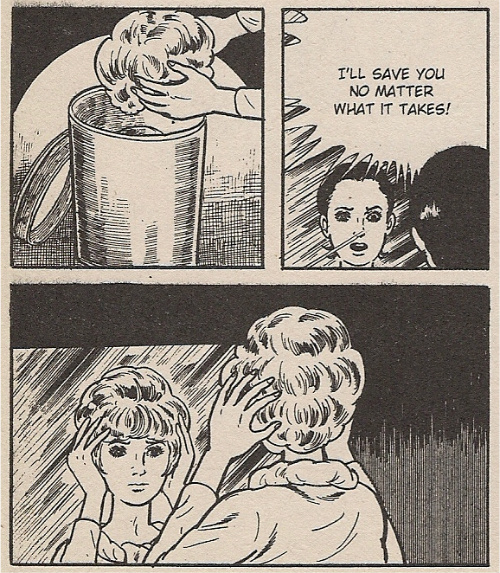

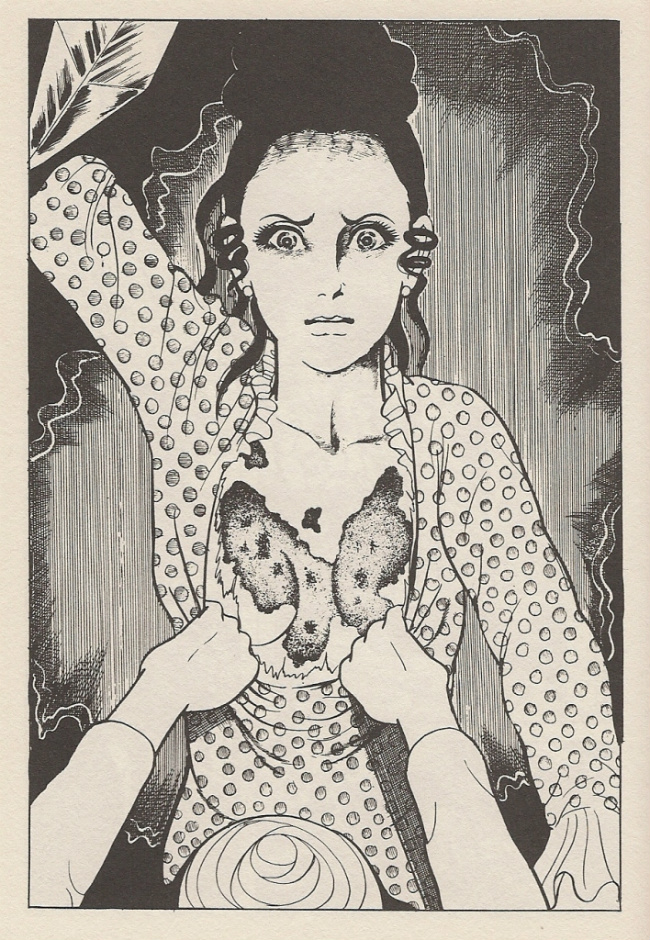

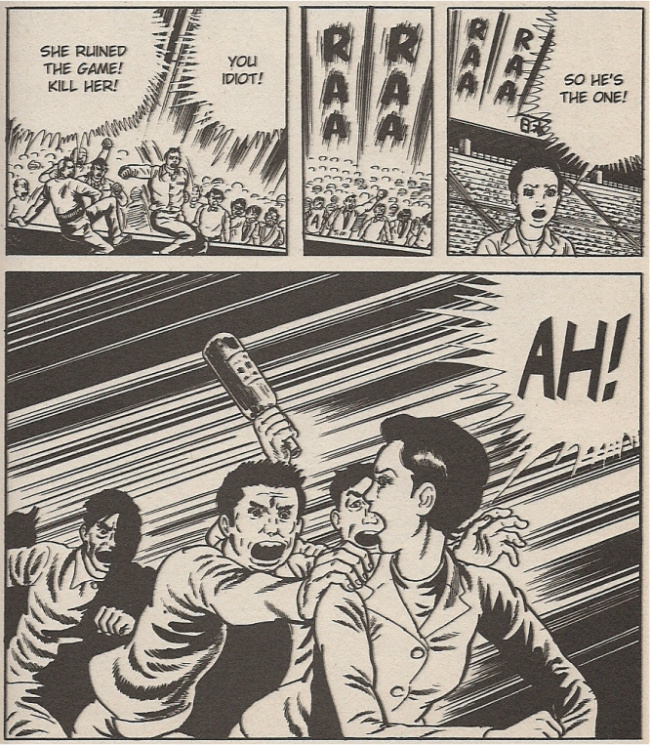

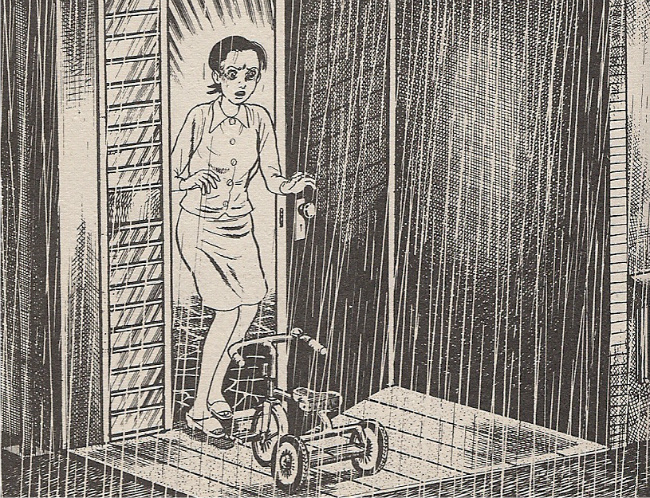
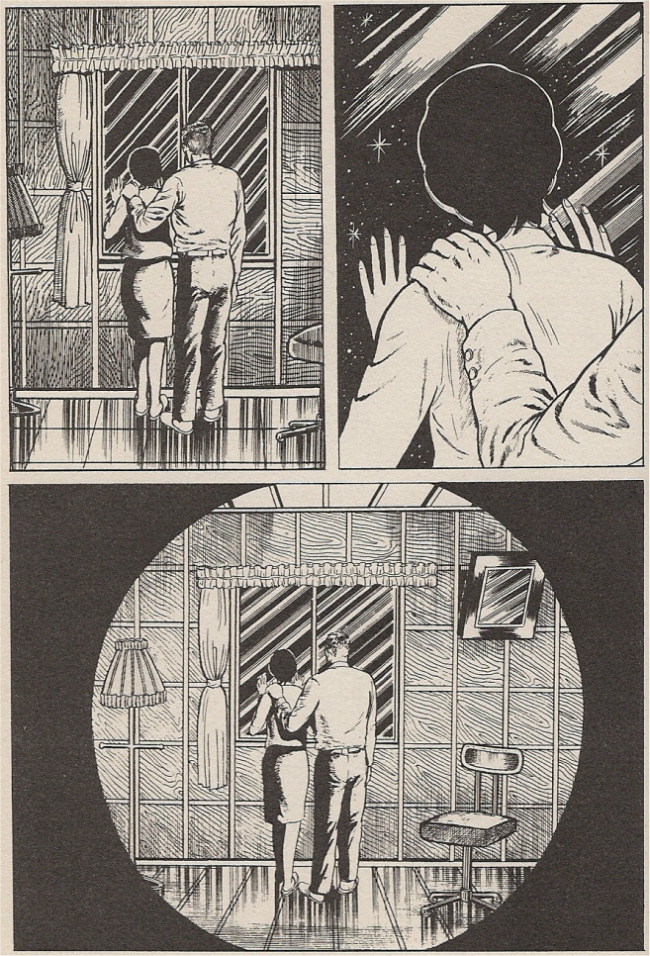
How do you get scans like that? Why do my scans always suck?
I have scan envy.
Oh yes…I love thinking about the story from Sho’s mom’s point of view. From Anne Allison’s book, I think you could say in a way that Sho’s mom is behaving just as she’s supposed to, almost; Japanese mothers were supposed to be almost maniacally focused on their children and their children’s success. Refusing to give up on her child no matter the evidence is a logical extension/parody of the dynamic Allison talks about, almost.
This is a beautiful, beautiful thing. I think I might need a re-read now of only the present day sections and none of that pesky horror/adventure stuff.
Pingback: Manga Xanadu » Blog Archive » Horror Manga Movable Feast: Day 6 Links